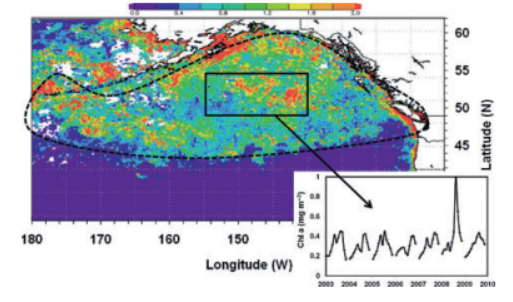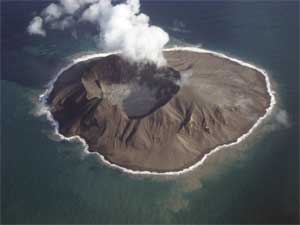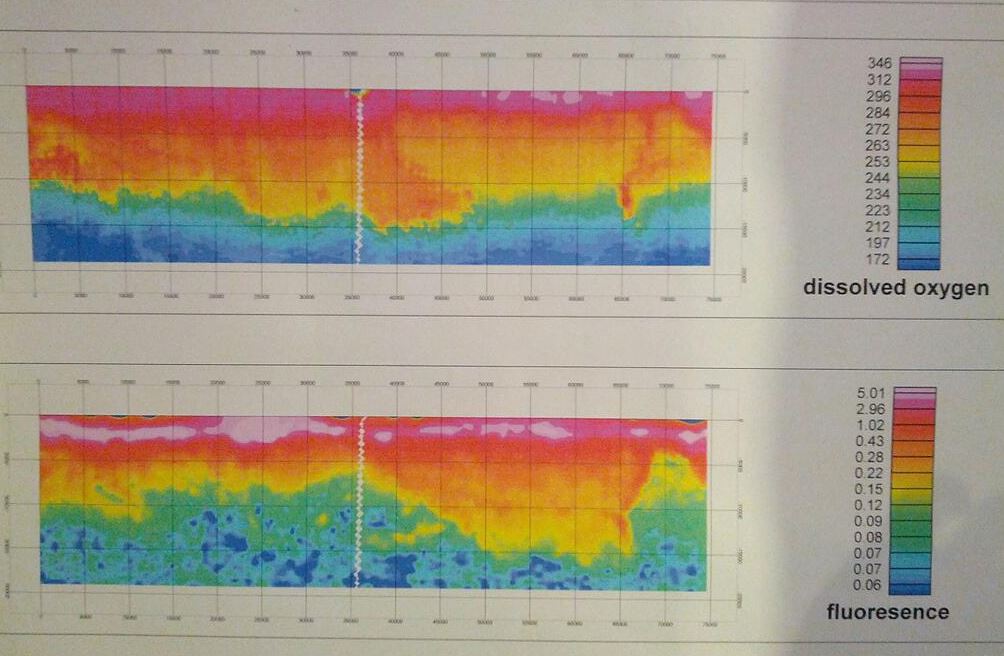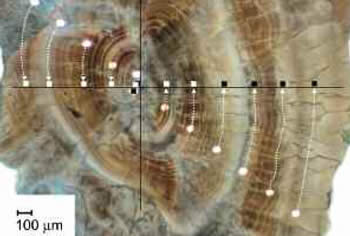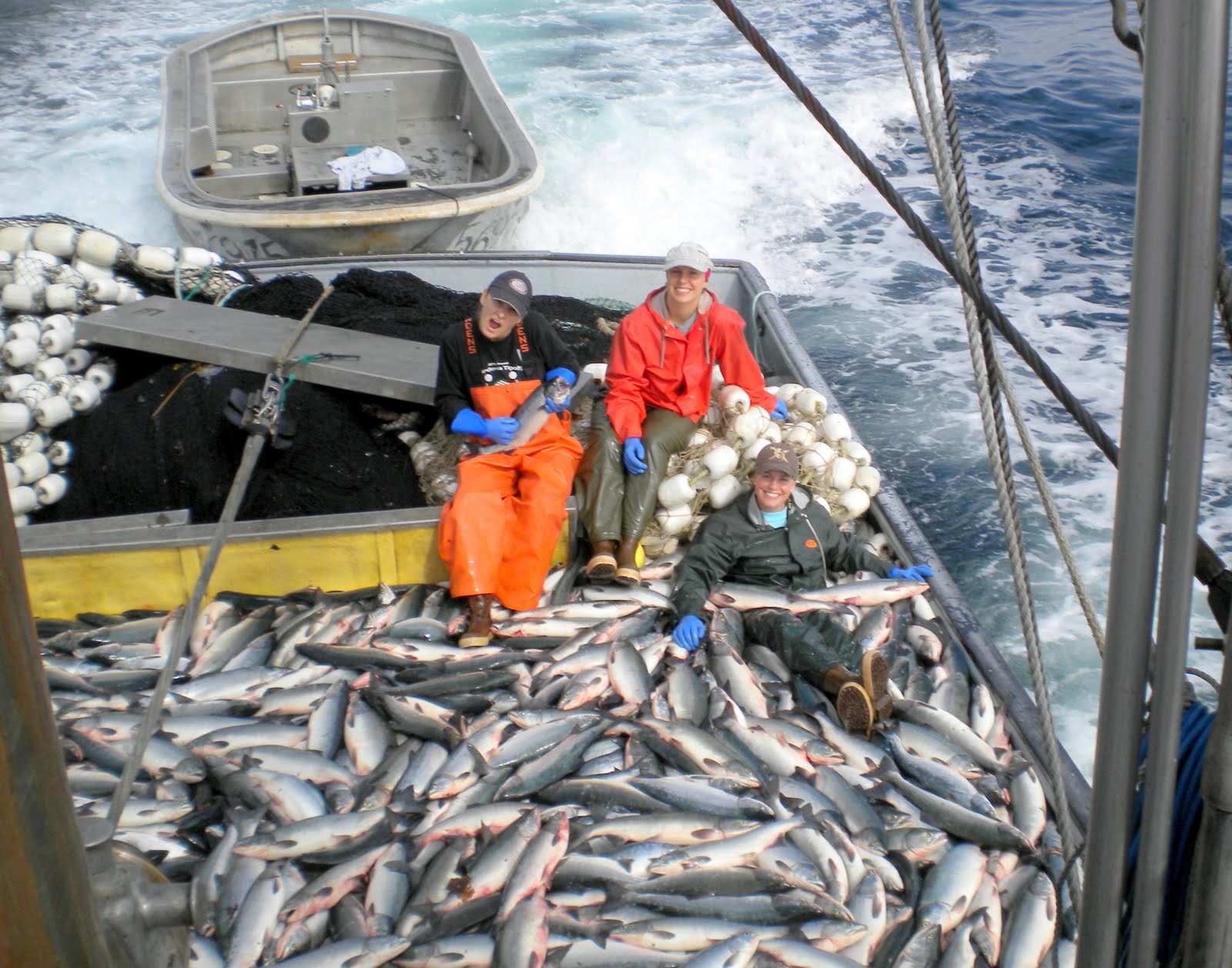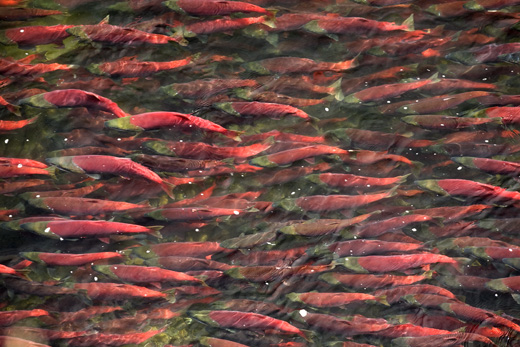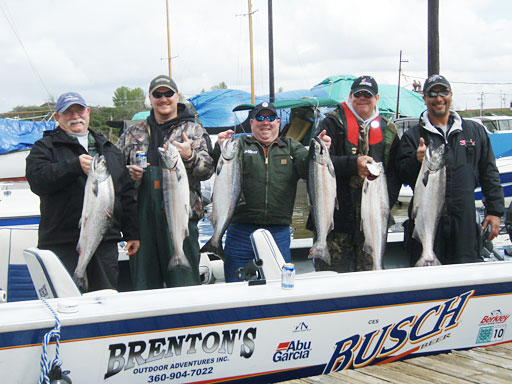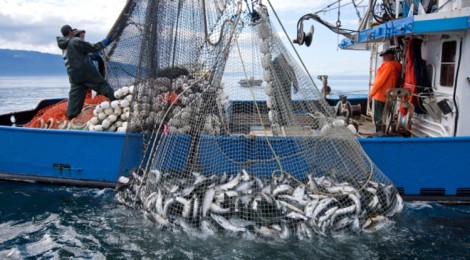
World’s First Commercial Scale Ocean Pasture Restoration A Phenomenal Success – It Won’t Be The Last
How To Bring Back Billions Of Fish, Feed The World’s Hungry – Ocean Pasture Restoration Repurposes Billions Of Tonnes Of CO2 Into Ocean Life
From the Columbia River north to Alaska salmon returns are proving to be among best in recorded history, according to reports by Fish and Wildlife officials and confirmed by throngs of happy fishermen. Seattle Times 14 June 2014
It’s not just some lucky accident of nature.
In 2012 after many years of development work my company Ocean Pastures completed a commercial-scale pilot project designed to restore and replenish a vital ocean salmon pasture in the N.E. Pacific. Ocean Pastures provided the technology, methodology, and scientific and engineering expertise via a limited technology license and other guiding business agreements with the Haida Salmon Restoration Corporation.
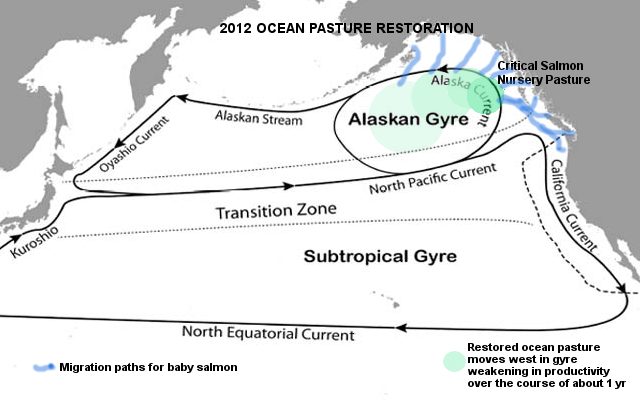
North Pacific Currents Define Salmon Habitat. The Green Pasture Patch Is Our 2012 Restored Ocean Pasture. It’s the most vital salmon nursery where most of the baby salmon from go to put on 95% of their adult body weight. (blue paths show their migratory routes.)
A key element in the project design was that I selected the location and timing for the work so that it would coincide with the migratory behavior of young salmon from SE Alaska, Canada, and the Pacific Northwest.
It’s well established that salmon from the rivers and streams of the West Coast of North America must make their way to the Alaskan Gyre where water temperatures and the ecology are matched to salmon biology. There on the ocean pastures those salmon will put on more than 95% of their body weight in the 2-4 years before the urge to return to spawn.
They reach the gyre as babies so it is an all important nursery for them. If the salmon were to go south of the North Pacific Current they would be swept into regions of the Pacific where the water is far too warm for them and which is filled with voracious predatory fish. Survival there is very unlikely.
I knew that the billions of baby salmon from this region that swim out the sea each year have been mostly starving and dying at sea and not coming home to us hale and hearty. The reason has been clear that they are dying because their vital ocean nursery pasture has been collapsing and not growing sufficiently to sustain the abundance of salmon it once did.
Pasture Restoration
If we could restore and replenish their vital nursery pasture the baby salmon would survive and thrive. Mother Nature had already shown us this worked when she dusted the region with mineral rich volcanic ash from the Kasatochi Volcano in August of 2008. The blooms that followed made it clear that this part of the world’s ocean are deprived of vital mineral micronutrients.
Even though the massively revived volcanic plankton blooms of 2008 were late in the season two years later the salmon came back in historic abundance, especially to the Fraser River which is the last major run of salmon to reach the Alaskan Gyre.
The Kasatochi volcano was not unique, two other volcanic eruptions of Aleutian volcanoes had similarly produced record sockeye salmon returns to the Fraser River.
Associated with those volcano miracle plankton blooms were countless records of desperately poor years for Fraser sockeye with matching poor ocean pasture conditions.
These studies of the natural system provide ample data for comparison of good ocean pasture conditions vs. poor one. Read about the Kasatochi volcano miracle run of Fraser River Sockeye or better yet watch the music video! The Wilds – 40 Million Salmon Can’t Be Wrong
In my experimental design I knew I could not produce an effect that would compare in size to the volcano. But we could be smarter than a dumb volcano. I could prescribe and administer exactly the right mineral micronutrients in exactly the right place at exactly the right time. All it would take would be me and 11 shipmates on one solitary fishing boat with a load of iron bearing dust. Along with a fantastic collection of our “state of the art” of ocean science tools of the trade.
My company Ocean Pastures and I organized the generous help and participation of many government ministries and non-government organizations in this ocean pasture restoration pilot project. These contributors provided us with fleets of state of the art ocean robots, ship board instruments, training programs and 50% of the salaries of some of our ocean scientists. Others sailed with us via satellite telepresence providing on-board expertise from world class ocean scientists and institutions who gifted their time to make sure our tiny crew could get the best out of our incredible ocean science instrument collection and project. Constant near real time hourly access to satellite remote sensing resources was provided by space agencies and private corporations in Canada and the USA.
IT JUST WORKS!
What results have we seen.
Aside from the tens of thousands of oceanographic samples that were collected before, during, and after the primary at sea ocean pasture restoration more than a hundred thousand discrete measurements were made of our pasture and the surrounding ocean.
That treasure trove of data is now being analysed by Ocean Pastures Corp. and while the majority of the data is proprietary and confidential in nature we’ll be preparing traditional scientific reports over time.
Among the best results are those the fish have brought back. Just think of every salmon as a dutiful ocean scientist who records in their every cell, scale, and fin a record of the condition of their ocean pasture.
When the salmon who lived in our restored and revived ocean pasture started swimming home in 2013 we were overwhelmed with reports of their numbers. Hundreds of millions of additional salmon over and above the numbers predicted by conventional fisheries science swam back to us with a second treasure trove of delicious data.
The SE Alaska Pink catch in the fall of 2013 was a stunning 226.3 million fish. This when a high number of 50 million fish were expected. Those extra ocean pasture fed fish came back because their pasture was enjoying the richest plankton blooms ever, thanks to me a 11 shipmates and our work in the summer of 2012. IT JUST WORKS!
This summer (2014) the Pacific Salmon commission projections are advising that this years Fraser River Sockeye Salmon runs will be the all time historic high, twice the previous record of 1900.
As many as 72 million of the bright red fish are expected where the largest runs in all of history have never exceeded 45 million. Even if the run is in the mid-range of the estimates at 25 million fish the run will be in the top 6 in all of recorded history.
.
From Columbia River to Pacific Ocean, salmon returns among best in recorded history, according to forecasts by state Fish and Wildlife officials. Seattle Times June 23, 2014 Officials are quoted, “
State fisheries released preliminary forecasts showing Columbia River chinook returns could rival those dating back to 1938. “That huge return of chinook has not been seen in more than 70 years. It should elevate the excitement level very high this summer,”
.
What’s Next
What’s next in our plans is repeating this work to restore and revive dying ocean pastures around the world. From our direct experience in both Pacific, Atlantic, and Indian oceans we know it works, we think just about everywhere. Within just a few years time, revived populations of ocean fish now dwindling, will be brought back, by our efforts, to historic levels of abundance.
We are determined to produce billions of additional fish that will make it into the nets and onto the plates of people around the world. We know that will happen as our experience in the North Pacific in 2012 resulted in more than 60 million servings of our healthy wild Pacific salmon that are right now being provided to hungry American kids who receive food aid from the US Department of Agriculture.
And as a bonus since the ocean pastures we restore and the abundance of fish we grow are carbon based life this all takes place through the repurposing of billions of tonnes of CO2 from it’s harmful form in the ocean into life itself. What could be better than that. The world’s most delicious solution to climate change.
I think it will bring a smile to Gaia’s face.
Read much much more on my blog www.russgeorge.net
References:
Fisheries Oceanography
DOI: 10.1111/j.1365-2419.2012.00630.x
Abstract: The effect of a widely distributed phytoplankton bloom triggered by volcanic ash from Alaska (Hamme et al., 2010. Geophys. Res. Lett. 37) on juvenile Fraser River sockeye is discussed in terms of the timing of ocean migration and trophic structure of the Gulf of Alaska. Our hypothesis is that the occurrence of a massive diatom bloom in the Gulf greatly enhanced energy ascendancy in the ocean at a time of year when adolescent sockeye migrated from the coast in 2008. We contend this increase in food availability was an important factor for the survival and growth of juvenile sockeye which led to one of the strongest sockeye returns on record in 2010
How Fish Cool Off Global Warming – Scientific American June 2014









